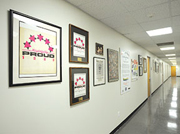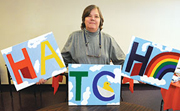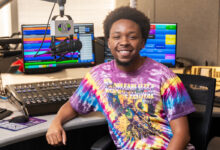One-Stop Shopping
Montrose Counseling Center meets Houston’s GLBT mental health needs—and so much more.
By Nancy Ford • Photos by Yvonne Feece

“Change is good” could easily be the motto of the Montrose Counseling Center.
From its undistinguished beginnings as a two-room practice at 900 Lovett Boulevard, the organization has grown to celebrate its 30th anniversary in its present location at 401 Branard Street, the expansive building that formerly housed the Fitness Exchange gym. After experiencing some surmountable pangs of adjustment, like air-conditioning and elevator issues, staff and clients alike have settled comfortably into their new home.
Montrose Counseling Center (MCC) was birthed in 1978 by the late William A. Scott, LMSW, and others, who recognized an unanswered need in Houston for mental health services that recognize and accept the range of human sexual orientation, rather than ignoring the fact or attempting to conform everyone to one accepted model of sexuality. As the decades passed, the center and its ever-expanding roster of programs needed to find more suitable lodgings to properly meet the mental health and behavioral needs of Houston’s sizeable GLBT community.
“We had three locations, and we were completely out of space in all three. It was difficult to manage because we had different programs in different locations,” MCC executive director, Dr. Ann Robison, says without a trace of longing for the old days. “It’s difficult to have communication paths between programs.”
Dr. Robison is marking her own milestone with 20 years of helming the center—20 years that have also brought big changes to the GLBT community. “Because the politics in society has changed and there are national TV networks now for the gay community, it is easier for people to come out, at least socially,” Dr. Robison says. “Maybe not interpersonally, [but] it is easier for them to come out. There may be less drama and trauma on a macro scale. We have more tools to work with for them to read. We have movies we can tell them to watch. There’s the Internet where they can get resources. We have our hotline now. People are still struggling with the same issues, but there’s more support now.”
Despite the increased visibility of gay men and lesbians in the media, Dr. Robison realizes GLBTs face serious challenges peculiar perhaps only to the GLBT community.
“We still see a lot of people, though, [for whom] it is very dramatic and traumatic for them personally, and whatever their situation is with their friends and their family and their work.”
_______________________

Dr. Robison believes that obtaining grant money to fund the center’s various programs is also a bit easier now than it was in 1978 when the word “gay” was likely to cause a grant proposal to be relegated to File 13. Oddly enough, the advent of HIV, she says, helped to increase the availability of funding for other GLBT programs.
HIV “kind of paved the way,” Dr. Robison says. “It became easier for people to talk about sexuality and risk factors and all of that because of HIV. I think that has made it easier for people to talk about sexuality period, even when it doesn’t have anything to do with risk behaviors. It just has to do with our general mental health grants or anti-violence grants. I really do think that the more openness has to do with HIV.”
The counseling center, Dr. Robison says, provides far more services than those dealing exclusively with HIV or coming out. “When somebody comes to us, they never have just one problem. They may be HIV-positive, but that may not be why they’re coming in here,” she says. “Or they may be coming in here because of their substance use or because somebody’s committing violence against them, but it’s rare that people just have one issue that they need to deal with. Sometimes it’s a dilemma to determine with them which one’s prominent and where we should start.”
New programs are implemented over time, based on what clients tell staff they need, explains Dr. Robinson. “We take our cue from what the clients in the community tell us that they’re not able to get anywhere else.”

In the mid ’90s, the center’s anti-violence program was implemented after a series of people sought counseling after having been assaulted. “It culminated in this one person who said he’d been set on fire outside of his apartment because somebody thought he was gay,” Dr. Robison says. “Well, he was gay, but it was a hate crime. There really were no hate-crimes-funded services in the whole state at that time.”
A similar situation gave birth to the center’s sexual assault and domestic violence programs. “After a period of time of trying to help mainstream organizations provide services to the gay community, it finally became apparent that those programs are not set up to deal with anything but the floods of women and their children that are coming for services,” Dr. Robison says. “To step outside of that norm and try to deal with a man who’s coming in for services or try to deal with somebody who’s trans for those services—they can’t do it. It’s not because they don’t want to, and it’s not that they don’t even sometimes have gay staff. Sometimes, the other clients are the biggest barriers to people receiving appropriate services.”
Two of MCC’s most visible and enduring programs are HATCH (formerly known as Houston Area Teen Coalition of Homosexuals) and the Gay & Lesbian Switchboard; both entities formerly existed autonomously. “There’s a lot of people who still don’t know they’re even part of us,” Dr. Robison says, laughing. “Both the switchboard board and the HATCH board were struggling with administrative stuff, and it was very frustrating for them,” she explains. “It was taking away the time their volunteers had to work with the kids and their programming.” Because both the switchboard and HATCH were small programs, the counseling center was able to adopt them, absorbing the accounting and the bookkeeping.
“We wanted to make it very clear that these programs are still intact—they just had a new parent,” Dr. Robison says. “It was also important, particularly with the kids, with the youth, that it not appear as though HATCH was turning into a mental health program, because it’s not.”
_______________________
Though mathematically unconfirmed, it’s likely that with its 47,254 square feet, the sprawling GLBT counseling center is the largest in the country. Accordingly, MCC’s acquisition of the massive building on Branard has impacted Houston’s gay community in a way that goes well beyond serving its expanding mental health needs.
“With this building, we wanted to, of course, have room for our own growth,” Dr. Robison says. “But we also wanted a lot of the little community organizations and little nonprofits who maybe don’t even have staff to have a permanent mailing address, and to have a permanent place to meet. We have tried to make this a one-stop shopping place for behavioral and social services for the gay community.”
The center’s first floor is filling the need for those organizations.
“If they needed an office, we have office space down there,” Dr. Robison says. “Our vision is that it will be the hub of the gay community. It was very important, and we have enough space to do it.”
The entire first floor, dubbed the GLBT Cultural Center, has been designed to be as community-friendly as possible. Organizations may meet in the clean, well-lit, multi-sized rooms for as little as $25.
“We want to truly be the place the community considers its home. Whatever organization it is, whatever meeting group it is, we hope they’ll think first about meeting here,” Dr. Robison says, “not only because it’s a safe place and because it’s going to be a place where other people meet and they’ll run into their friends, but we’re also hoping that they would do it also to support the community.”
The gay Catholic group, Dignity, holds meetings and Mass at MCC’s Cultural Center. Other diverse groups meeting on the first floor include National Leather Association-Houston, AssistHers, Pride Houston, and Kindred Spirits, with groups lining up to join their number.
“We have a very large, flexible, almost conference-space room that we would like to see used more,” Dr. Robison adds.
The vast space offered by the center has acted as a two-fold blessing to Gulf Coast Museum and Archive. Not only have its board members taken an office at the center, but the historical preservation group has also begun displaying items in a rotating exhibit on the first floor.
“They have a lot of stuff they need to display in a space where it can be seen and where there will be traffic that’s not just brought in by them, so it is a win-win,” Dr. Robison says.
The Houston GLBT Community Center is another group considering making its home in the spacious building. “The community center is moving forward with negotiations with Montrose Counseling Center to move in sometime after the first of the year,” community center president, Christopher Bown, told OutSmart in November.
_______________________
Despite its apparent success with the recent expansion, the center still deals with the same single challenge it has faced since its inception. “As with all the other nonprofits, we are certainly pretty nervous about the financial situation” states Dr. Robison. “But our greatest need now? It’s kind of cliché, but money is always an issue. I think that the community thinks that we’ve been so stable for so long that we don’t need their support, and that always surprises me. It always kind of pains us when we see gay organizations giving money to organizations outside the gay community. But you know, it’s their money, it’s their right to do. But we need to support services for gay people.”
Montrose Counseling Center (MCC) belongs to the National Coalition of Anti-Violence Programs, which addresses sexual assault, domestic violence, and hate crimes toward the GLBT community. For a complete menu of all the services and programs provided by MCC, log on to montrosecounselingcenter.org.

Rooms with a View and a Vision
Montrose Counseling Center (MCC) has approximately 50 meeting rooms available for sponsorship. Twenty-five of those rooms have been snapped up by generous individual and group donors, in exchange for the privilege of naming the rooms.
The rooms, decorated and furnished according to the wishes of the donors, bear recognizable community names like Marion Coleman, Bunnies on the Bayou, John Danielson, Houston Black Tie Dinner, Jack Jackson, Jerry W. Simoneaux Jr., Ralph Herring OD MHA, and others.
Based on his general community involvement, especially with the Executive Professional Association of Houston (EPAH), Dr. Herring was asked to preside over the MCC’s endowment board. “I don’t know anything about counseling other than counseling patients,” admits the optometrist by trade. “I just felt like it was something under the radar, that a lot of people didn’t know what was going on over there.”
MCC has two boards: the executive board and the endowment board. The endowment board, MCC’s “landlord,” deals with things like “building codes and roofs and how many parking spots you can put in and how you put an elevator in,” Dr. Herring explains. “It’s not glamorous, it’s practicalities. But if there’s no building, there’s no counseling center.”
Dr. Herring echoes Dr. Robison’s sentiment stressing how important it was for the center to remain in Montrose. “We’re so glad we found that place,” he says. “We didn’t think about it at the time, but it was worth all the aggravation we had to deal with. It took a year, but it was worth it. I wish there had been something like MCC when I was growing up and figuring out who I was.”











Comments